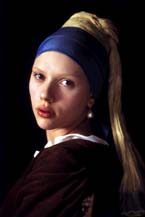



|
GIRL WITH A PEARL EARRING (2003) Directed by Peter Webber
Starring Scarlett Johansson, Colin Firth
Rated PG-13 Length 95 minutes
Summary 1664. Holland. Griet (Scarlett Johansson) is a 16-year-old girl from a poor family who is hired as the Vermeer family's maid. Johannes Vermeer (Colin Firth), of course, is the famous painter still revered to this day. Tension between the contemplative, slightly verbal artist and curious, timid Griet grows as tensions between Johannes' attention-hungry, jealous wife, his eldest daughter, and his shrewd mother-in-law likewise mount. Griet is awarded special privilege in the artist's hallowed studio and soon he entrusts her with mixing paint - and eventually posing for a portrait, wearing his wife's pearl earring. The famous painting, Girl With A Pearl Earring, of course, is the result. (Comparison between the work and Scarlett Johansson's portrayal can be seen near the top of this page.)
Review Book-based films seem to have no in-between when it comes to accuracy and worthiness. They are either excellently rendered or poor failures. Some stinkers include The Grapes of Wrath, The Stand, From Hell, etc. Fortunately I've found a good number of such films to be well-done: Rumble Fish (which was a remarkable improvement of S.E. Hinton's work), Misery, Papillion, 2001: A Space Odyssey, Dune, Get Shorty, to name some. Girl With A Pearl Earring succeeds in visualizing Tracy Chevalier's delightful novel of the same title. And the triune context of the film, the novel, and the inspiring painting lends a peculiar depth to Vermeer's haunting legacy and the imagination of the elements involved in his creation.
I read Chevalier's novel in 2001, finding it surprisingly clever and enchanting. From then on my appreciation for the painting itself deepened. I began to wonder about the individual subjects of paintings, in general. And I appreciated Chevalier's speculation on the pearl earring, how it came to become a prop, who it belonged to, etc. My interest in Vermeer's work was encouraged. When I initially learned of the film I had conflicting reactions. On one hand I was thrilled, considering this to be a coincidental extension of the effect the book and painting has on me years ago. On the other hand I feared the tone and truth of the book might be warped by a clumsy or vulgar script writer or director. The innocence might be omitted and replaced by typical Hollywood-stock erotica, for instance. I held my breath.
Despite my past worry, I can now attest that Girl With A Pearl Earring is Vermeer in motion, remarkably lighted and textured, emulous of the very painter it celebrates. Characters' pauses become momentary paintings, some recognizably derivative of Vermeer's works.
The film may be considered somewhat sluggish by the less patient, but even when characters languish (particularly Griet), they seem brimming with life, colorfully thoughtful. Johansson's non-verbal acting is captivating. Slight movements of her lush mouth, for example, emote more than any scripted line could. Her eyes, too, transcend words: watchful, observant, deeply sad, thirsty for knowledge and interpretation. In this Firth's Vermeer also excels. He's a starer rather than a speaker. Just as he mutely channels others into almost photographic art, Vermeer understands his annoying wife's insecurity, his mother-in-law's austere financial concern, his older daughter's bitterness, and Griet's humble potential hiding under her servile station.
A peek at a scene: mother-in-law, wife, and Vermeer repose in a dim room while Griet clears a table nearby. Griet is careful not to disturb the tense quiet, but she is starkly aware of Vermeer's presence, his attention. Johannes stares indiscreetly at Griet, though his wife faces him. He's a man who slips into trance-like inscrutability, with hardly a concern of how this shakes the tempers of the less meek and good women in his life. He seems a prisoner who is only liberated by his private eyes, his precise art.
The closest Johannes and Griet ever come to completely exposing their mutually curious attraction (in both the book and the film) is when the artist insists that Griet, his favored helper turned portrait subject, wear his wife's pearl earrings. Griet obliges, but asks Johannes to do the piercing. This teeth-gritting, painful act is perhaps the sublimated breaching of the maidenhead that literally would be wrong and, frankly, the typical choice in a more vulgar story.
Other enjoyable aspects of this film were the dated depictions of a maid's hardships and duties and the formal procedures of life in 17th-Century Holland. I am amazed at the film's almost magical guessing of my mind's eye, reconstructing the book-ignited imagination onto the film screen. Few films have succeeded so in my experience.
Oddly and somewhat sadly, Vermeer's original painting of the girl (whose historical identity has been and continues to be speculated about) is less beautiful to me after seeing Scarlett Johansson play the role. Johansson is much more pleasing to the eye. When Vermeer's painting was shown at the very end of the film, I realized how much the actresses' portrayal paled the actual work. But I don't regret the change. When I lose myself in the mystery and calmness of the painted, captive moment and girl, I still hold my breath.
review by D. Herrle 2/2004
|
|
[back to top] [home] |
|
© 2004 SubtleTea Productions All Rights Reserved |